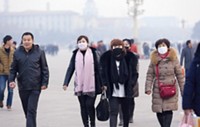Advertisement
Grab your lab coat. Let's get started
Welcome!
Welcome!
Create an account below to get 6 C&EN articles per month, receive newsletters and more - all free.
It seems this is your first time logging in online. Please enter the following information to continue.
As an ACS member you automatically get access to this site. All we need is few more details to create your reading experience.
Not you? Sign in with a different account.
Not you? Sign in with a different account.
ERROR 1
ERROR 1
ERROR 2
ERROR 2
ERROR 2
ERROR 2
ERROR 2
Password and Confirm password must match.
If you have an ACS member number, please enter it here so we can link this account to your membership. (optional)
ERROR 2
ACS values your privacy. By submitting your information, you are gaining access to C&EN and subscribing to our weekly newsletter. We use the information you provide to make your reading experience better, and we will never sell your data to third party members.
Environment
As Chinese manufacturing booms, residents choke
Manufacturing rebound in China could be short-lived if authorities crack down on pollution
by Jean-François Tremblay
January 9, 2017
| A version of this story appeared in
Volume 95, Issue 2

Bucking a general slowdown in economic growth, China posted its best manufacturing performance in four years last month. However, worsening air pollution in many Chinese cities could cause authorities to clamp down on the chemical plants and other factories that are contributing to this strong performance.
“Manufacturing companies in China reported the strongest upturn in operating conditions since January 2013 at the end of 2016,” reports Caixin Insight Group, a financial data provider. Caixin publishes a monthly Purchasing Managers Index that, like its U.S. equivalent, provides a reliable assessment of the health of the manufacturing sector.
“Production expanded at the fastest pace in nearly six years, supported by a solid increase in total new work,” Caixin said.
Caixin was unable to decide if the Chinese economy, slowing for the past three years, is accelerating again. Whereas the economy grew at annual rates exceeding 10% for most of the past 20 years, the Asian Development Bank estimates that China expanded at 6.6% in 2016, a rate lower than India’s.
The manufacturing resurgence could be threatened by dangerously high levels of air pollution in northern China. The U.S. Embassy in Beijing, which is equipped to measure outdoor air quality, reports that its Air Quality Index repeatedly exceeded 400 last week, a level it considers “hazardous.” Northern China has been shrouded in dangerous smog for most of this winter.
China has reacted to its toxic air by increasing controls on manufacturers or ordering them to suspend operations. On Dec. 30, the Beijing Environmental Bureau said it was inspecting manufacturers in the vast city for possible violations of emissions regulations. In November, China had ordered the temporary suspension of production in the northern part of the country. Among those affected were some major Chinese drug manufacturers, including CSPC Pharmaceutical.
Some foreign chemical producers see China’s struggle to improve its air quality as a source of business opportunity. Firms including Lanxess, Henkel, and BASF are working with car manufacturers in China to develop lightweight parts that help lower fuel consumption. Last year, BASF disclosed that it created an emissions catalyst for the Chinese car manufacturer Geely.




Join the conversation
Contact the reporter
Submit a Letter to the Editor for publication
Engage with us on Twitter